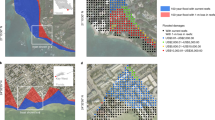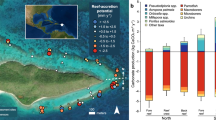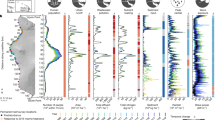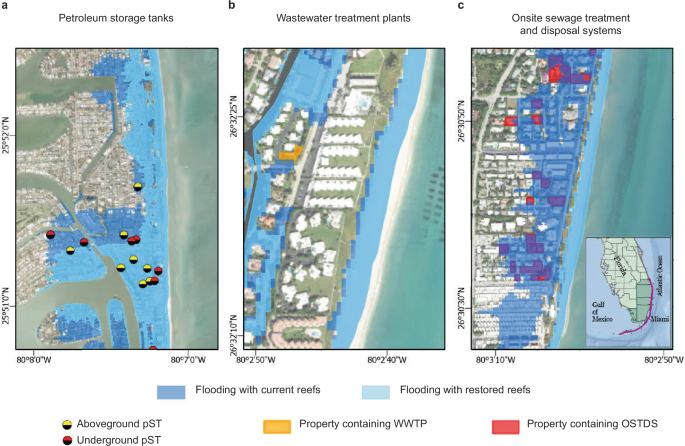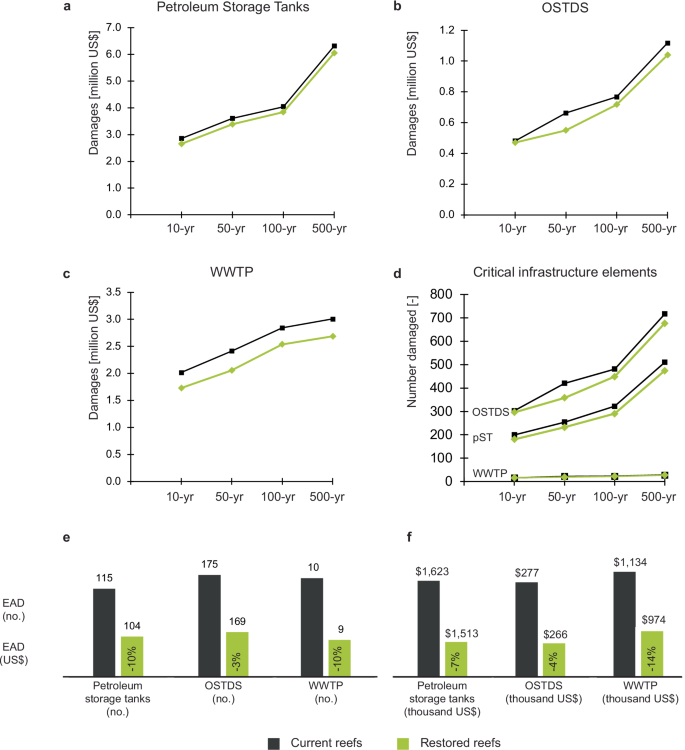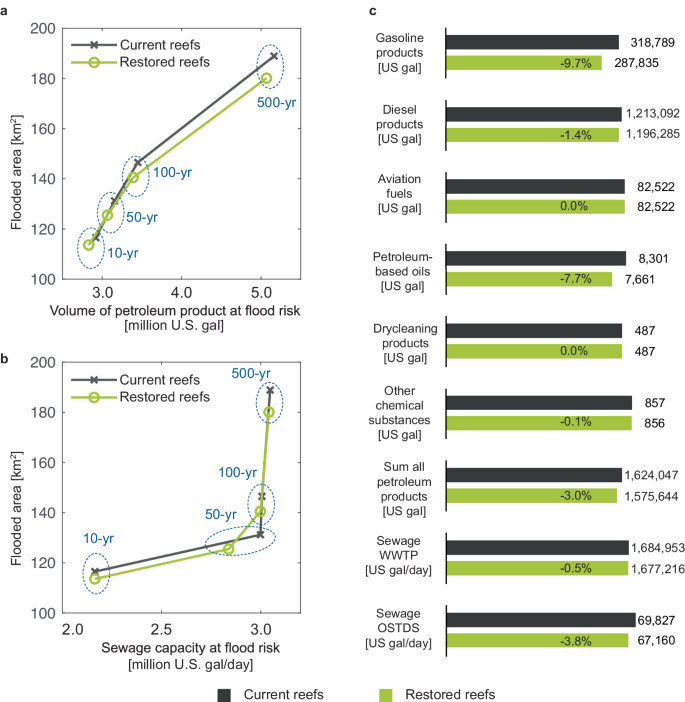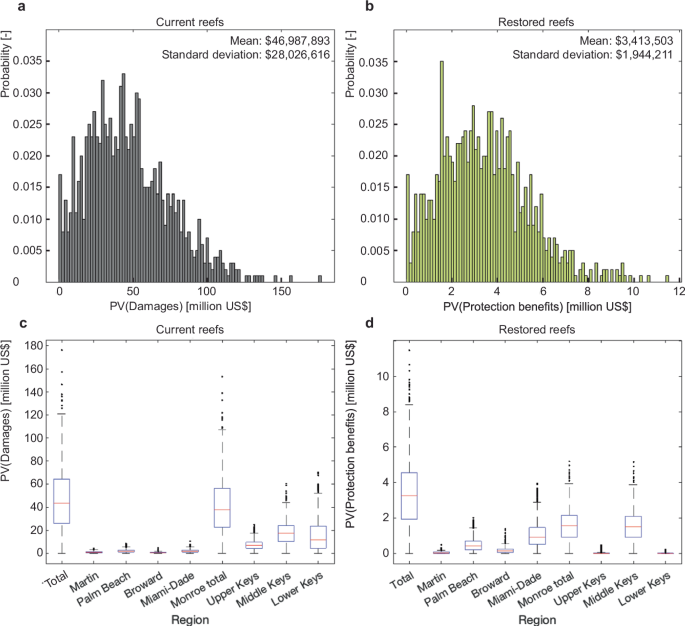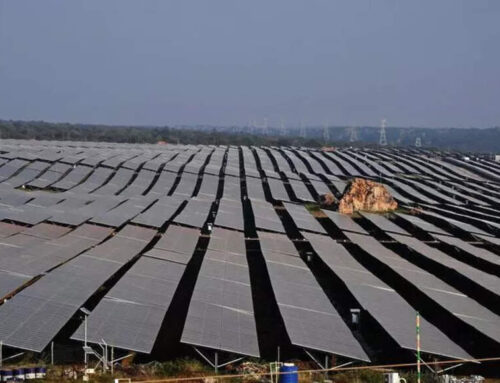Coral reef restoration can reduce coastal contamination and pollution hazards
January 25, 2025
Abstract
Coral reef restoration can reduce the wave-driven flooding for coastal communities. However, this protection has yet to be assessed in terms of the reduced risk of flood-driven environmental contamination. Here we provide the first high-resolution valuation of the reduction of flood-related land-based environmental pollution provided by potential coral reef restoration. Along Florida’s 460 km-long coral reef-fringed coastline, coral reef restoration could reduce the risk of sewage and petrochemical contamination by preventing the flooding of petroleum storage tank systems (-9%), onsite sewage treatment and disposal systems (-4%), and wastewater treatment plants (-10%). The present value of critical infrastructure protection and contamination prevention benefits provided by coral reef restoration is $3,413,503, with some areas exceeding $1,500,000/km. Annually, 48,403 U.S. gal of petrochemicals, 10,404 GPD of wastewater treatment capacity, equivalent to $281,435, could be protected from flooding, demonstrating that coral reef restoration can provide environmental risk reduction and previously undocumented additional socioeconomic benefits.
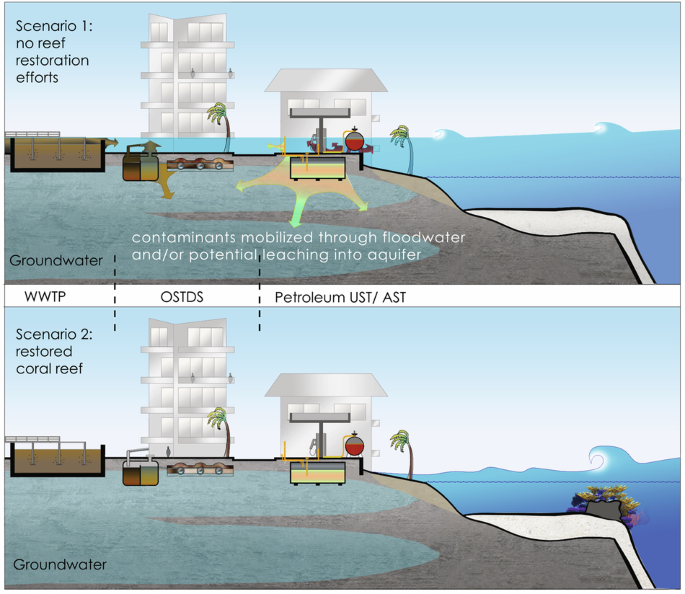
Similar content being viewed by others
Introduction
Wave-driven coastal flooding caused by tropical storms imposes a serious threat for coastal communities1,2. Flooding is also a serious threat for infrastructure containing toxic substances such as gasoline, diesel, drycleaning agents3,4,5,6, and sewage7,8,9 because flood damage can cause leaks and spills during which toxic products can be released into the environment, causing a health hazard for people and organisms10. With accelerating sea-level rise, and increase in storm frequency11, coastal flood hazards are increasing and thus so is the potential for storm-driven contamination.
Critical infrastructure elements (CIEs) with the potential for environmental contamination include petroleum storage tanks (pSTs), onsite sewage treatment and disposal systems (OSTDSs), and wastewater treatment plants (WWTPs). There is a need to rigorously assess the hazard caused by coastal flooding for pSTs, OSTDSs and WWTPs. First, pSTs are used for fuel supply, storage, emergency generators in private and public places. Nearly all buildings of a municipality either have a type of OSTDS or are connected to a sewer grid that transports sewage and wastewater to a centralized municipal WWTP. Second, flood-related contamination with sewage and petrochemicals poses serious short- and long-term health hazards: sewage contains pathogens, and thus can spread infectious diseases, e.g., hepatitis12, pneumonia13, typhoid fever, cholera, tetanus, or gastroenteritis14,15. Exposure to petrochemicals can cause irritation, respiratory and neurologic problems16, and leads to endocrine disrupting activity17,18, carcinogenicity, mutagenicity, and acute toxicity17,19 and additional burden for health care providers. Third, cascading effects for an affected region can be triggered, both through direct contact or if the pollutants enter aquifers and contaminate drinking water. Fourth, environmental remediation efforts can range from US$1000s to US$1,000,000s per spill, with a median ~US$100,000 and are not always able to restore to the state prior to the contamination incident (C. Brunot, oral communication, 12/05/2022). Fifth, there is a financing and insurance gap for owners to cover the financial burden of environmental remediation efforts20,21,22,23, for some cases insurance does not cover damage remediation. This can result in an additional burden on public funds when private insurance does not cover the costs, and pST owners are forced to apply for government funding for cleanup24. Lastly, because at-risk, vulnerable populations (low-income, elderly, and other minority populations) are often adjacent to CIEs25,26,27 and thus suffer from the negative consequences of contamination28, assessing the impact of flooding and the resulting environmental contamination on such communities is an environmental justice issue.
Coastal communities have traditionally invested in different gray coastal engineering solutions to mitigate coastal flooding, such as seawalls and breakwaters29. However, studies have shown that natural features such as mangroves, beaches, marshlands, and coral reefs can provide flood protection30 as well as environmental benefits (e.g., nutrient supply, biogeochemical cycling31,32). Coral reefs can attenuate 97% of incident wave energy33 through friction and wave breaking34,35 by acting as submerged breakwaters. This reduction in wave energy and associated reduced coastal flooding potential has been valued in terms of averted building damages and indirect economic interruption of billions of US dollars annually in the US36,37 and tens of billions of US dollars annually worldwide38. Because of this, coral reefs have become recognized as national, natural infrastructure for coastal protection by the U.S. Coral Reef Task Force39. However, there is still a need to increase pre-disaster mitigation and post-disaster recovery funding opportunities for coral reef restoration for coastal flooding risk reduction at larger scales40. This is important as coral reefs have been degrading in many locations worldwide due to climate-driven changes and pollution, and thereby the flood hazard protection has been reduced36,37,41 and might continue to decrease. This can aggravate the flooding hazard at reef-fringed coastlines globally if no restoration action is taken42. Because such hazard risk reduction funding is based on traditional cost-to-benefit analyses, a more refined valuation of the coastal protection benefits provided by coral reef restoration37 is essential to increase such funding possibilities.
To the best of our knowledge, the role of coral reef restoration in reducing damage to CIEs with potential environmental contamination has not yet been evaluated. To address this, we assess coastal flood hazards to CIEs in Florida that can cause environmental contamination and value the coastal protection function that potential coral reef restoration can provide to reduce that risk. We chose five counties in southeast Florida, U.S.A., as our study area due high economic activity (GDP of $353 billion in 202143), dense population (6,401,716 people in 201944), high frequency of tropical storms45, and low coastal topography46 that are broadly representative of populated coral reef-lined regions across the globe. We match information on the flood risk reduction provided by theoretical coral reef restoration36 with newly assimilated information on pSTs, OSTDSs, and WWTPs that could be damaged and potentially cause environmental contamination. The CIE protection and contamination prevention (CPCP) benefits are defined as damages to CIEs and potential resulting environmental contamination that can be adverted with coral reef restoration compared to the current state of coral reefs. Second, we advance the precision of the computation of economic damages and economic benefits, in 2022 USD, provided by coral reef restoration by presenting results as probability distributions, in addition to singular expected values, to provide a holistic presentation of flood contamination risk.
Results
Reduction of flood-related damage and contamination risk
The restoration of coral reefs can avert economic damages that otherwise can occur when CIEs are flooded and subsequently damaged during wave-driven flooding events. Damages are defined as those to CIEs that limit their functionality and operability and cause related potential environmental contamination that require either repair or replacement of the element itself, as well as potential environmental remediation and cleanup of the surrounding area. Associated with these damages are the costs of repair and/or replacement of CIEs and environmental remediation measures. Our results focus on pSTs, OSTDSs, and WWTPs, and therefore do not include facilities with other industrial hazardous waste and thus are a conservative underestimation of the total possible contamination.
Number of critical infrastructure elements protected
Coral reef restoration considered here consists of a solid structure with outplanted coral on top and total elevation increase of 1.25 m and width of 5 m in cross-shore direction (refer to Methods for details) is projected to reduce the number of pSTs, OSTDSs, and WWTPs (Fig. 1) at flood risk.
a Petroleum storage tanks, pSTs, with above ground in yellow and underground in red. b Wastewater treatment plants, WWTPs. c Onsite sewage treatment and disposal systems, OSTDSs. The dark blue areas indicate the areas that are in a flood hazard zone for current coral reefs and the light blue areas indicate the reduced flood zones with coral reef restoration. Orange areas represent the spatial extent of wastewater treatment plants and red areas indicate properties containing an onsite sewage treatment and disposal system. Coral reef restoration is projected to reduce the size of coastal floodplains, reducing the flooding of properties containing pSTs, OSTDSs, and WWTPs and the resulting environmental contamination.
The 100-year floodplain has a 1-percent chance of experiencing a peak water level in any given year; however, during the span of a typical 30-year mortgage, the 100-year floodplain has a 26-percent chance of being flooded at least once47. For the 100-year flood scenario, 32 pSTs (−10%), 32 OSTDSs (−7%), and 1 WWTPs (−4%) are projected to be protected from flooding (Fig. 2d) by potential coral reef restoration in Florida.
Flood risk for (a) pSTs, b OSTDSs, and c WWTPs per storm return period in terms of mean economic damages and d the number of critical infrastructure elements at risk of flooding. The dark gray color represents the flood risk with current coral reefs, the green color with restored coral reefs. The space between the black and green line represents the damages adverted due to coral reef restoration. All values represent mean values of the distributions in Figs. 4 and S2. e Expected annual damages with regards to the number of critical infrastructure elements (label on top of columns) and percentage averted (percentage in green columns). f Expected annual damages with regards to the economic damages (labels on top of the columns) and percentage adverted (percentage in green columns). The dark gray bars indicate the damages projected for current coral reefs and the green bars indicate damages for restored coral reefs. Coral reef restoration can reduce the number of flooded pSTs, OSTDSs, and WWTPs and related economic damages per storm return interval and thus annual damages. The critical infrastructure element (CIE) protection and contamination prevention (CPCP) benefits of coral reef restoration are dependent on the storm return interval and vary by type of critical infrastructure.
By integrating across the different storm return intervals, we computed annualized expected values. Annually, 11 pSTs (−10%), 6 OSTDSs (−3%), and 1 WWTPs (−10%) are projected to be protected from flooding by restored coral reefs (Fig. 2e). The forecasted CPCP benefits are greater for private owners (residential and businesses, land retail stations, marine fuel storage) than public owners (federal, state, local, and municipal governments) and depend on the respective storm return interval (Supplementary Fig. 1a). Because coral reef restoration is projected to reduce the number of flooded CIEs, it will likely also reduce the number of newly contaminated sites.
Volume of petrochemicals and capacity of sewage protected from flooding
By reducing the number of flooded CIEs, coral reef restoration is projected to decrease the volume of petroleum product and sewage capacity at risk for a given storm. For the 100-year floodplain, 59,300 U.S. gal of petrochemicals and a sewage capacity of 7500 U.S. gal per day (GPD) (Fig. 3) are projected to be protected from flooding with restored coral reefs in Florida.
a Relation between the volume of petroleum product at flood risk and the flooded area for different storm return intervals. The dashed circles indicate the values that correspond to a particular storm return interval (10-year, 50-year, 100-year, 500-year). b Relation between the capacity of sewage at flood risk and the flooded area for different storm return intervals. c Expected annual damages (label to the right of bars) and percentage avoided (percentage in green bars) with regards to the volume of petroleum products stored and the capacity of sewage treated in zones with flood risk. Dark gray bars indicate the volume of contaminants stored in floodplains based on current coral reefs and green bars represent those in floodplains with restored coral reefs. Coral reef restoration is forecasted to reduce the volume of gasoline, diesel, other petroleum-based liquids, and the capacity of sewage at flood risk during wave-driven coastal flooding events and thus is projected to lessen the extent of environmental contamination by those pollutants.
In the study area, 48,403 U.S. gal (−3.0%) of petroleum products and a sewage capacity of 7,737 GPD (−0.5%) from WWTPs and 2,667 GPD (−3.8%) of sewage from OSTDSs are projected to be protected from flooding by restored coral reefs annually. These disaggregate into projected annual flood protection of 9.7% (30,954 U.S. gal) of gasoline products, 1.4% (16,808 U.S. gal) of diesel products, 7.7% (640 U.S. gal) of petroleum-based oils, and 0.1% (1 U.S. gal) of other chemical substances (see Methods for details). Due to the location of pSTs containing aviation fuels (82,522 U.S. gal) and drycleaning products (487 U.S. gal) relative to projected floodplains, annually none of these are forecasted to be protected with coral reef restoration. With coral reef restoration projected to reduce the volume of petroleum-product and sewage capacity at flood risk, it will reduce the overall environmental burden and necessity for cleanup measures for a given region.
Economic benefits of coral reef restoration
The present value of CPCP benefits describes the economic damages arising from CIE damage and environmental contamination, over a given period for a specified region that can be prevented from occurring with a restored coral reef. We hereby assumed a 30-year period and a discount rate of 7%, as commonly used by the U.S. Federal Emergency Management Agency (FEMA)48 and the U.S. Army Corps of Engineers. The U.S. federal discount rate was reduced from 7 to 3.1% in 2024, thus our results can be considered conservative. In Florida, coral reef restoration is projected to have a mean present value of CPCP benefits of $3,413,503 ± $1,943,238 (mean ± standard deviation), a 7.3% reduction in risk (Fig. 4).
Damages refer to physical damage to critical infrastructure elements and the resulting environmental contamination with petrochemicals and/or sewage. Economic damages include costs for repair and/or replacement of those critical infrastructure elements, as well as costs for environmental remediation and cleanup. a Histogram of the present value of damages, PV(D), for current state of coral reefs. b Histogram of the present value of CPCP benefits, PV(B), provided by restored coral reefs. c Distribution of the PV(D) per county for current coral reefs. d Distribution of the PV(B) provided by restored coral reefs per county. For subplots (c) and (d), the blue horizontal lines indicate the 25 and 75% quantiles, the red horizontal line represents the median, and whiskers display the minimum and maximum values; extreme values are denoted by points. For all plots, a discount rate of 7% and 30-year lifetime were assumed.
Per county, the mean present values of CPCP benefits range from US$51,338 to $1,570,072, with a mean ± standard deviation of US$628,159 ± US$689,115 (Table 1). A total of expected annual protection benefits of US$281,435 are projected for Florida (Fig. 2), with the counties ranging from US$756 to US$158,324, with a mean ± standard deviation of US$54,970 ± US$68,338 (Supplementary Table 1). Per CIE type, mean present values of CPCP benefits disaggregate into US$1,568,239 ±US$974,399 (5.4%) for pSTs that currently store petroleum product, US$5,369 ± US$27,342 (5.7%) for empty pSTs, US$199,922 ± US$167,526 (5.1%) for OSTDSs, and US$1,639,972 ± US$901,467 (11.7%) for WWTPs (Table 1).
Expected annual CPCP benefits for pSTs are US$110,000 (7%), for OSTDS US$11,000 (4%), and for WWTPs US$160,000 (14%). For areas in the 100-year floodplain of coral-fringed Florida, reef restoration can provide mean CPCP benefits to CIE of US$553,005 ± US$377,715 (7.2%) (Supplementary Fig. 2). Coral reef restoration is thus projected to reduce the financial burden for post-disaster measures for reconstruction of the functionality and operability of CIEs and environmental remediation for a given region.
Spatial differences in CIE protection and contamination prevention (CPCP) benefit distributions
Florida has 460 km of coral reef-fringed coastline, of which 226 km (49.1%) are forecasted to experience CIE and potential flood contamination damages over the next 30 years due to wave-driven coastal flooding events if reefs remain unrestored (“current reefs�). Coral reef restoration is estimated to protect CIEs along 81 km, equivalent to 17.6% of total coastline, and 35.8% of coastline for which damages are projected.
Depending on the section of coastline considered, restored coral reefs are projected to offer mean present values of CPCP benefits ranging from US$0 to US$1,560,000/km, with a mean ± standard deviation of US$7,421 ± US$83,286. For the 100-year storm, coastal protection benefits can range from US$0/km to US$900,000/km, with a mean ± standard deviation of US$4,620/km ± US$44,189/km (6.0%). Expected annual CPCP benefits are forecasted to range from US$0 to US$493,200/km, with a mean ± standard deviation of US$2,254/km ± US$27,228/km. Therefore, per kilometer of coastline, between 0 and 99.7% of annual damages, with a mean ± standard deviation of 8.1 ± 22.5%, are projected to be averted by restored coral reefs. Thus, although coral reef restoration might not avert damages for some sections of Florida’s reef-fringed coastline, it is projected to reduce the flood-related damages and contamination for some coastal segments almost entirely.
Discussion
Coral reef restoration can protect critical infrastructure from damage and coastal communities from environmental contamination resulting from wave-driven coastal flooding events. Our results demonstrate that coral reef restoration in Florida could protect pSTs, OSTDSs and WWTPs from flood-related damages and spills that are equivalent to expected annual economic protection benefits of US$281,435 (2022 US$); as noted in the Methods, these numbers are conservative, as we did not consider smaller fixed or mobile sources, and we used conservative radii of the polluted environment. With regards to total flood-caused contamination in Florida, our results are conservative, as we do not consider additional sources, such as facilities with industrial or hazardous waste.
Previous studies have already addressed flood reduction benefits of coral reef restoration of more than US$156,400,000 in averted economic disruption and US$168,184,000 in averted damage to buildings49 and the protection of 2,249 people annually50 in Florida. Our results are additional benefits on top of the already analyzed, as they add an additional aspect that has previously not yet been documented. The quantification of further benefits is important as coral reef restoration can cost, depending on location, method and materials selected, between US$0.15 million/km and US$3 million/km, with average costs below US$2 million/km50 (Supplementary Table 2 for details), and with increasing innovation, costs might further decrease. CIE protection and contamination prevention benefits vary by kilometer of coastline and depend on different geophysical, topographic, and CIE factors. The 249 km-long reef-lined coastline along continental Florida (Martin, Palm Beach, Broward, and Miami-Dade Counties) has 11.8% higher CPCP benefits (US$1,801,733) than the 211 km of the Florida Keys (Monroe County; US$1,611,769), as presented in Table 1 and Fig. 5. The spatial distribution of benefits along the coastline differs along these two geographies: whereas for the continental part there are 69 km of coastline potentially benefitting from coral reef restoration reducing environmental contamination, there are only 11 km in the Florida Keys, of which only 1 km in the Middle Keys (Vaca Key) being the main driver for the benefit (Fig. 5) based on our analysis of considered contaminant sources.
a Expected annual economic damages per 1-km coastal segment forecasted for current coral reefs. b Expected annual CPCP benefits restored coral reefs are projected to provide per 1-km coastal segment. c Mean present value of damages to critical infrastructure elements for current coral reefs. d Mean present value of CPCP benefits restored coral reefs could provide per 1-km coastal segment. Coral reef restoration can substantially reduce the coastal hazard risk of flood damages to CIEs and subsequent contamination; however, the damages and protection benefits are highly spatially variable due to the nature of the coral reefs and distribution of infrastructure potentially causing contamination.
Geophysical factors include the depth of the coral reef, its proximity to shore, and its cross-shore width. The shallower the coral reef, the closer to shore and the narrower the reef, the greater the reduction of projected floodplain size and flood hazard50. In general, coral reefs along continental Florida are narrower, more continuous, fringing reefs compared to those in the Florida Keys51,52,53,54 that are a discontinuous barrier coral reef at an average distance of 10 km from shore53,55.
Further contaminant sources and contaminants
To assess the flood-associated contamination risk with sewage, we focused on properties containing OSTDSs and small WWTPs. However, municipalities with centralized wastewater treatment systems also have a network of sewer pipes which also pose a flood contamination hazard56,57; these were not considered in this analysis due to domestic security considerations. Furthermore, wave-driven coastal flooding can affect cesspools58 in regions where these are prevalent, and these can become a health hazard for people and the environment when flooded59,60,61,62,63.
Further sources of pollutants, such as sites with hazardous waste treatment and disposal, incinerators10 and hazardous waste generators, storers, transfer, and transport facilities64 can also be a source of pollution if flooded. Flood waters containing fungal spores from untreated sewage represent a further biological flood-related contamination health hazard, as they can enable the growth of mold in flooded buildings65. Even seawater by itself can be considered a contaminant by causing soil salinization66, inhibiting agricultural production67,68, and/or limiting freshwater availability69. Thus, if restored coral reefs can protect the flooding of CIEs and other contaminant sources, it can reduce the chances that new sites of contamination develop.
In our study, we considered the damage of pSTs, OSTDSs, and WWTPs and potential spills of sewage and petroleum products that can cause newly contaminated sites for which we considered environmental remediation costs. However, we have not considered the flood hazard for sites of known, existing contamination, such as those listed in government agencies’ cleanup programs70,71,72,73, or solid waste landfills10. Thus, coral reef restoration would also reduce the flood hazard for sites of known, existing contamination for reef-fringed tropical coastlines. This way, it could reduce the economic and environmental burden for coastal communities associated with post-disaster recovery and environmental remediation. Further studies on additional contaminant sources, sites of known contamination, and related times of exposure to flooding are necessary to assess further flood contamination risks.
Cascading effects and environmental justice
Environmental contamination from acute and chronic flood damage to pSTs, OSTDSs, and WWTPs can trigger cascading effects beyond the scope of damages to CIEs and related environmental cleanup and remediation, leading to negative externalities for different stakeholders, including far higher associated economic and social costs: there can be hazard, flood risk management system, CIE, spill-over, and snowball cascades74. Acute flood damages of pSTs can cause downtimes for public and private buildings, emergency energy supply with emergency generators, and disrupt the provision of basic functions of system-relevant infrastructure. Contamination remediation costs for buildings beyond direct flood damage can arise75 and health care providers will likely be burdened with flood-contamination caused illnesses76.
Flood damage to CIEs can affect different stakeholders at different times, from the time of flood contamination to years after such event has occurred. Questions of liability and health risk can arise if contamination remains undetected, property ownership changes, or contaminants migrate and new property owners or neighbors are faced with payments for environmental remediation and potential insurance gaps77. Public and common assets of uninvolved third parties, i.e., schools, groundwater wells, natural reserves, or the properties of private homeowners can become polluted78. Sites near those pollution sources are disproportionately inhabited by vulnerable peoples, including minorities, low-income, and at-risk groups, such the elderly, children, minorities, and low-income peoples79. These populations have less access to legal counsel, insurance, and political advocacy80 to remediate contamination that may affect them directly or indirectly. By averting flood damages to CIEs and avoiding flood-related environmental contamination for various areas and different functions within coastal communities, coral reef restoration can reduce the short- and long-term human health hazard, and thus foster environmental justice. Therefore, the CPCP benefits quantified in this study are but a small portion of the expected benefits from reef restoration, which are substantial, but more difficult to quantify.
Negative cyclical effects of environmental land-based pollution on the coastal protection function of coral reefs itself can also occur. The over-supply in nitrates and phosphates from leaking wastewater treatment systems can alter the species composition81, change the rate of calcification in coral reefs82, and enhance rates of bioerosion or site-specific eutrophication83 that can, in turn, foster increased rates of coral reef degradation and thus lead to an increase in coastal flooding42.
The existing interdisciplinary risk quantification valuation framework with high-resolution flood modeling36,37,38,49 has been adapted with Monte Carlo simulations to present projected damages and benefits as probability distributions in addition to singular expected values. First, for decision-makers who are risk-averse, the probability distribution of damages matters beyond a singular expected value. Singular expected values are often used by engineers to provide information on risk84,85, and assume a risk-neutral decision-maker within the concept of utility theory84. However, decision-making on flood management is addressed at the federal, state, and local government levels in the U.S.86,87. It has been demonstrated that individual U.S. households are risk-averse88, and different U.S. government agencies, such as FEMA, state risk avoidance and reduction as a primary goal48,89. Second, for probabilistic risk assessment for human health90 and ecosystems, Monte Carlo simulations91 are frequently conducted by the U.S. Environmental Protection Agency (EPA) to determine the risk for populations exposed to hazards92,93. To address the coastal flood contamination risk for a risk-averse decision-maker, the present values of CPCP benefits are provided as probability densities (Fig. 4, Supplementary Fig. 2) that demonstrate that damages can be higher or lower based on a given probability. This method of Monte Carlo simulations is applied here for the first time to assess CPCP benefits restored coral reefs can provide.
Our results can be used by public decision-makers of government agencies, e.g., floodplain, cleanup, and coral reef restoration managers, and for interagency cooperation, to develop coastal protection, environmental remediation, and coral reef restoration measures along coral reef-lined coastlines at high resolution to reduce the coastal flood contamination risk, and to develop related, necessary funding mechanisms worldwide. Our findings can help private stakeholders, e.g., CIE owners, real estate developers, and planners, to take flood contamination risk into consideration into the design and construction of new and remodeling of existing structures to increase coastal resilience. For regions with little funding and technological mitigation means, but with a high risk of wave-driven coastal flooding67,68, coral reef restoration could reduce the future financial and environmental burden arising from environmental cleanup. Coral reef restoration therefore could contribute to the protection of common goods and peoples from flood-related environmental contamination, and it could thus be a measure to improve environmental justice for underserved communities.
Methods
General methodology
The proposed empirical methodology is derived from an expected damage function approach (EDF)49,85 and uses an interdisciplinary probabilistic risk valuation framework with high-resolution flood modeling36,37,49 (Supplementary Fig. 3). Our study area consists of the coastal areas of the counties Martin, Palm Beach, Broward, Miami-Dade, and the Florida Keys (Upper, Middle and Lower Keys) in Monroe County in Florida.
Datasets and infrastructure elements considered
We downloaded data from five geospatial datasets and considered three types of critical infrastructure elements: we downloaded projected high-resolution (10 m x 10 m) flood extents for different storm return intervals and coral reef restoration scenarios from the U.S. Geological Survey94. We considered registered petroleum storage tanks (pSTs) built in form of underground storage tanks (USTs) with capacity greater than 110 US gal as covered in Chapter 62-761, Florida Administrative Code (F.A.C.), and aboveground storage tanks (ASTs) with capacity greater than 550 US gal as covered in Chapter 62-762, F.A.C. The dataset contains ASTs with tank volumes below the required reporting threshold and we included these as well in our computations, because the exposed location of ASTs to flood waters create a risk for damage and spilling and also tanks with a small volume can cause economic and environmental damage. Stored petroleum-based products considered were different types of gasoline (leaded, unleaded, ethanol E10), diesel (vehicular, emergency generator, and generator pump diesel), aviation fuels (aviation gas and jet fuel), petroleum-based oils (fuel oil/ onsite heat, new/ lube oil, waste oil), drycleaning (drycleaning petroleum, tetrachloroethylene, drycleaning miscellaneous), and other chemical substances (chlorine compound, mineral acid, miscellaneous petroleum-based products and other non-regulated products). Two datasets with information on pSTs were used, one from the Florida Department of Environmental Protection (FDEP) Geospatial Open Data website95, and a second dataset with information on tank contents was provided directly by FDEP.
Furthermore, we considered onsite sewage treatment and disposal systems (OSTDSs) as defined in Section 381.0065(2)(k), Florida Statutes (F.S.), also referred to as septic systems. The dataset was directly provided by FDEP. An individual OSTDS was assumed to have a capacity of 400 US gallon per day. This number is based on the computed average median number of rooms of 4.68 in a housing unit in the five counties of our study96 and the capacity of OSTDSs required for a 4-bedroom residential unit according to 64E-6.008 Florida Administrative Code. We chose to round down to 4 bedrooms to conduct a conservative estimate.
Last, we investigated wastewater treatment facilities, also referred to as wastewater treatment plants (WWTPs) as covered in Chapter 403 F.S. and regulated by the Domestic Wastewater Program and Industrial Wastewater Program by FDEP. The dataset “Wastewater Facility Regulation (WAFR) – Wastewater Facilities� was downloaded from the FDEP Geospatial Open Data website97. The capacity of WTTPs in the study area ranges from 0.0024 MGD to 0.55 MGD. Digital cadastral maps for the five counties of the study area were downloaded from the Florida Department of Revenue98.
Our study represents a conservative approach by assessing the flood contamination risk for pSTs, OSTDSs and WWTPs that are officially registered with the Florida Department of Environmental Protection, respectively, Florida Department of Health. We also assumed a conservative zone of impact of environmental contamination of CIE damage. However, CPCP benefits provided by coral reef restoration for petrochemical exposure could even be higher if further contamination sources of anchored nature (i.e., storage tanks for emergency generators below the threshold) or mobile nature (i.e., petroleum tanks of cars, trucks, boats; portable toilets) were included, and if the radius of the assumed polluted environment is assumed to be larger.
Coral reef restoration specifications and flood scenario development
Storlazzi et al. 49developed models of coastal flooding with current reefs and theoretically restored reefs. The restored coral reef scenario describes a restoration scenario that consists of a solid structure with outplanted live coral top with total vertical height increase of 1.25 m and a cross-shore width of 5.0 m that were situated in water depths between 2 and 7 m on continuous coral/hardbottom habitat and located at the closest point to shore. There are two ways how this could be achieved: (a) either outplanting of tall (mature) live coral, i.e., Acropora palmata, (b) a structural or “gray� restoration with a concrete or metal base structure and juvenile corals rescued from elsewhere or grown in nurseries outplanted on top. Such a base structure in combination with the outplanting of live coral is often referred to as a “hybrid� restoration. Storlazzi et al. (2012b) modeled each of the reef scenarios (current reefs, restored reefs) for 10-year, 50-year, 100-year, and 500-year storm return intervals. Along the study area, per kilometer of coastline, a theoretical reef restoration location was determined based on the bathymetry of the seafloor for depths between 2 and 7 m.
Number of critical infrastructure elements affected and protected from flooding
We determined the number of pSTs, OSTDSs, and WWTPs affected and protected from flooding with a quantitative geospatial analysis in ArcGIS Pro. All locations of CIEs within a distance of 500 m of the largest floodplain (500-year storm return interval, current reefs) were individually verified with Google Maps (satellite imagery), Google Street View, and ArcGIS Pro Imagery Hybrid map to account for spatial inaccuracies. A detailed description of the procedure can be found in the following three subsections.
Number of pSTs
The location of each individual petroleum storage tank within a property corresponding to an address was verified with Google Maps, Google Street View, permit documents and annual inspection reports found at respective links in the FDEP datasets. pSTs located higher than the second story of a building were excluded, since we assumed that flood waters will not reach these storage tank systems. The point layer containing the location of pSTs was intersected with each of the eight floodplain layers. Hereby, the tool spatial join with a radius of 15 m was selected to account for the spatial extent of a storage tank and floodplain uncertainties. For each of the eight flood scenarios, the number of flooded pSTs was calculated.
Number of OSTDSs
The location of OSTDSs as provided in the datasets was at the street level. For each of the flood scenarios, we intersected the polygon layer containing polygons of properties with OSTDSs with each of the floodplains to determine the projected flooded area of the properties. Then, the areas of the flooded space of each property containing an OSTDS was measured for each of the flood scenarios. Subsequently, for each property containing an OSTDS, the spatial ratio (alpha) of flooded property area to total property area was calculated and a spatial cut-off ratio of 20% was used. If α was greater or equal to 20%, it was defined that the OSTDS on that property was flooded. If less than 20% of the property area was flooded, it was defined that the OSTDS was not flooded. We justify a spatial ratio (alpha) of 20%, because on average only a limited area within a property is suitable for an OSTDS to be constructed as there are spatial requirements (open space free of trees, roots, no other built structures on top that could damage the absorption field). Since OSTDSs considered consist of the basic modules of septic tank, absorption field and related piping, by the physical principle of communicating vessels we assume that if one part of an OSTDS is flooded and flood water enters the system somewhere, parts, or even the entire system can become damaged and sewage spills can occur somewhere in the system. Therefore, we considered the use of a ratio (alpha) = 0.2 as the cut-off value, which means one fifth of the property being flooded, a reasonable cut-off value. Based on this computation, for each of the flood scenarios, the state of a particular OSTDS (flooded/not flooded) was determined. The number of OSTDSs flooded for a given scenario was determined by counting the number of properties containing an OSTDS with a spatial ratio (alpha ge) 20% for a given flood scenario.
Number of WWTPs
The addresses of WWTPs were provided as a point feature class. We verified the location of the property corresponding to an address with Google Satellite Images, and ArcGIS Pro Imagery Hybrid map. We then further refined the WWTP’s spatial extent within a property with information found in official permits, permit construction drawings, and annual inspection reports. A respective link to a FDEP database to access these documents was found for every entry of the FDEP dataset. The WWTP polygon layer was intersected with each of the floodplains and the area of the flooded area within the WWTP was computed. Similar to the OSTDS, the spatial ratio (alpha) of flooded area to total area of the WWTP was calculated. Again, a spatial cut-off ratio of 20% was used to determine the state (flooded/ not flooded) of a WWTP for a given flood scenario.
For each storm return interval, the number of pSTs, OSTDSs, and WWTPs protected from coastal flooding with restored coral reefs was computed as the difference between the number of flooded pSTs for the scenario with current reefs for a given storm return interval, and the number of pSTs with restored reefs for the same storm return interval:
with N being the number of critical infrastructure elements and m being the type of critical infrastructure element (pST, OSTDS or WWTP).
Modeling of damage scenarios and cost functions for petroleum storage tanks and OSTDSs
Based on an online market review (Supplementary Tables 3–5) and a thorough literature search (Supplementary Table 6), we investigated different types of petroleum storage tank and OSTDS damages and failures during wave-driven coastal flooding events, possible contamination scenarios, and necessary environmental remediation actions after a petrochemical or sewage spill. We verified this information by interviews with experts (three certified professional geologists, one industrial hygienist, and one pST manufacturer) that currently work, or have previously worked on projects in the study area (Supplementary Table 7). Based on the information gained, we developed different potential damage scenarios, including damage trees with probabilities and cost functions for flooded pSTs and OSTDSs during wave-driven coastal flooding events. Overall, we considered costs associated with the repair and/or replacement of a pST and costs for environmental remediation after a petroleum product spill. Hereby, based on the information provided in the datasets, we further differentiated between pSTs carrying petroleum product and currently empty pST, to account for the environmental contamination hazard for pST carrying petroleum product (Supplementary Figs. 4–7).
For OSTDSs, we considered the repair and/or replacement of an entire OSTDS or different parts of an OSTDS (septic tank, absorption field), as well as costs for environmental remediation after an OSTDS has leaked and caused a sewage spill. We then created different damage scenarios with decision trees, one for pSTs containing petrochemicals, one for empty pSTs, and one for OSTDS (Supplementary Figs. 8 and 9). To model the costs per damage scenario, we chose PERT distributions with parameters minimum, most likely, and maximum values, as it is suggested in Vose99. The parameters of each PERT distribution were determined based on the extensive literature and market search and verified with interviews with above-mentioned experts. We determined the probabilities of damage and leaking of a flooded petroleum storage tank during a storm event with the help of already mentioned expert interviews in combination with Historical Sea, Lake, and Overland Surges from Hurricanes (SLOSH) simulations of 10 previous hurricanes100,101. A SLOSH simulation is a computational model to simulate storm surges. For OSTDSs, we identified related damage probabilities based on our results found in the literature search and then allocated the estimated damage probabilities to our different possible events in our decision trees. Decision trees for pST and OSTDS damage can be found in Supplemental section are not described here in detail due to a lack of space to include in manuscript.
Modeling of damage scenarios and cost functions for WWTPs
Since WWTPs consist of different components and the spatial extent is larger than for pSTs and OSTDSs, we estimated flood damages based on a damage degree, instead of individual damage scenarios. We used the damage function approach for WWTPs as suggested in Sun et al. 102
which is also used in FEMA HAZUS Flood Modeling for the estimation of direct economic loss to utility system components due to flooding103, and modified it to fit the context of our study. We required modifications, because the WWTPs we considered in this study are smaller than the WWTPs considered in HAZUS104. Hereby, economic damages (US$ loss) for a WWTP are computed as the product of percent of damage (% Damage) and the value of a WWTP. Based on the spatial ratio (alpha) of flooded area to total area of the WWTP that we previously found with the quantitative geospatial analysis, we assumed a corresponding flood depth and percent of damage. For (alpha < 0.2) we assumed a flood depth of 0 ft and 0% damage. For (0.2,le alpha < 1.0) we assumed a flood depth of 1 ft and an assumed damage degree (% Damage) = 5%. For (alpha =1.0) we assumed a flood depth of 3 ft and an assumed damage degree (% Damage) = 10%. These assumptions can be considered conservative flood depths and damage degrees. We based the value of a WWTP on the average construction costs of a WWTP in dependence of its capacity (Supplementary Fig. 10). For WWTPs with capacity lower than 0.1 MGD, we found construction costs for different biological nutrient removal processes in dependence of different capacities as used by the EPA105. Thereof, we computed average construction costs in dependence of capacity, and with interpolation we determined the value of our WWTPs in dependence of their capacities. For WWTPs of capacity between 0.1 MGD and 0.55 MGD we found the actual average construction costs published106. All found monetary values were converted to 2022 US$.
Assessing economic damages and economic CIE protection and contamination prevention (CPCP) benefits provided by coral reef restoration
For the estimation of economic flood damages and the projection of economic flood protection benefits restored coral reefs can provide, we used Monte Carlo simulations with 1000 iterations (Supplementary Fig. 11). We used two different types of Monte Carlo algorithms, one for the estimation of the present values of damages and CPCP benefits at different scales (per kilometer of coastline, per county, total study area) and one other type for the assessment of damages and benefits projected per storm return interval (10-year, 50-year, 100-year, 500-year). The latter one becomes also relevant for the computation of expected annual damages and benefits (refer to paragraph “Expected annual damages and benefits“ below). The 460 km long coastline was divided into 1 km wide coastal segments.
The algorithm to determine the present values per county and study area is described here. For each iteration, per year (ranging for year 0 to year T (maturity)), we randomly chose a storm of a given storm return interval (10-year, 50-year, 100-year, 500-year; no storm) and corresponding probability of occurrence (1/10; 1/50; 1/100; 1/500; 0.868). We assumed that if a storm hits, every coastal segment of length 1 km along the coast can be affected. For each pST and OSTDS within the flooded region, we chose a random respective damage scenario based on previously determined damage probabilities, and we randomly chose a value for occurring costs based on previously modeled PERT distributions. For WWTPs we used previously determined economic losses based on damage degrees. We then took the occurred damages for each individual CIE and summed up the economic damages per regional scale (per kilometer of coastline; per county; per study area). We repeated this procedure for each year from t = 0 to maturity t = T and discounted each year with a discount rate (see formula below). We then computed the present value of damages (PVleft(Dright)_s,c,i) and the present value of CIE protection and contamination prevention (CPCP) benefits (PVleft(Bright)_s,i) by summing up over the damages, respective benefits of all T years with
Hereby s is the regional scale (per coastal segment, county, total study area), c is the coral reef restoration scenario (current reefs, restored reefs), i is the number of iteration, t is the time in years from year 0 to T (time of maturity), and r is the discount rate. We used a maturity T of 30 years and a discount rate r of 7% as it is commonly used by FEMA and the U.S. Army Corps of Engineers. The U.S. federal discount rate was reduced from 7 to 3.1% in 2024, thus our results can be considered conservative.
The mean present value of economic damages (PVleft(Dright)_s,c) describes the flood damages to critical infrastructure that are estimated to occur over a specified period of time, for a specified region, a particular state of coral reef and assumed discount rate. The mean present value of economic CIE protection and contamination prevention (CPCP) benefits ((PVleft(Bright)_s)) describes the amount of economic damages (PVleft(Dright)_s,c) over a given time period for a specified region that can be prevented from occurring with a restored coral reef, compared to the present-day state of a coral reef (“current reefs�).
The (PVleft(Dright)_s,c,i) and (PVleft(Bright)_s,i) were computed for three different scales: per coastal segment of length 1 km, per county, and for the total study area. We repeated this computation 1000 times (1000 iterations; for clarification: damage scenarios and storm return intervals were randomly chosen based on damage probabilities for each iteration), and then computed the mean and standard deviation over these 1000 iterations to determine the mean (PVleft(Dright)_s,c), mean (PVleft(Bright)_s), and corresponding standard deviations for different spatial ranges and coral reef restoration scenarios. All mentioned monetary values were converted, or computed with, 2022 US$.
Expected annual damages and expected annual CIE protection and contamination prevention (CPCP) benefits
Expected annual damages (EAD_s) are defined as the projected annualized damages for a specified area arising from damaged critical infrastructure and potential spills. We used Monte Carlo simulations to compute expected annual damages and expected annual CPCP benefits. Hereby we modified the above-described Monte Carlo simulation by selecting a specific storm return interval and by shortening the lifetime to only one year. We then used the average value per storm return interval to compute expected annual economic damages and economic protection benefits with trapezoidal integration based on Olsen et al.107:
with s being the scale (coastal segment, county, total study area), i representing the respective storm return interval (10-year, 50-year, 100-year, 500-year). 1/ Ti is the respective annual exceedance probability (1/10, 1/50, 1/100, 1/500). Di represent projected mean damages per respective storm return interval.
For expected annual CPCP benefits coral reef restoration can provide, we computed the difference in predicted mean flood losses between a state with present-day coral reefs and a state with restored coral reefs:
Both expected annual damages and expected annual CPCP benefits were further computed for four additional types of parameters: (1.1) the number of CIE projected to be flooded; (1.2) the number of CIE projected to be protected from flooding; (2.1) the estimated volumes of petroleum products and the capacity of wastewater treatment at flood risk; (2.2) the estimated volumes of petroleum products and the capacity of wastewater treatment projected to be protected from flooding.
Discussion of uncertainties of quantitative geospatial analysis
In our model we assumed that floodplains remain constant over a lifetime T = 30 years. This means we assumed the state of current and restored coral reefs also remains constant, and thus there is no degradation of coral reefs over time. However, future continuous coral reef degradation can occur if coral reefs are not restored and if the threats that killed the reefs in the first place are not mitigated, and this would change the floodplain corresponding to the state of current reefs for a given year. Furthermore, climate change impacts the severity of storm events, and a storm event of certain magnitude and annual exceedance probability can be classified as an event with lower annual exceedance probability (10-year storm can become 5-year storm in the future).
Discussion of uncertainties of Monte Carlo simulation model
There are 6 CIE factors that affect the CPCP benefits per length of coastline: (1) the number of CIEs per coastal segment, which is related to the population density and type of CIE technology of a municipality (i.e., centralized wastewater treatment vs. OSTDS); (2) location of a CIE relative to the wave-driven floodplains; (3) number of storm return intervals for which a CIE is protected, as this affects the present value of CPCP benefits and expected CPCP benefits; (4) type of CIE protected, as there are different repair and/or replacement costs for different types of CIEs; (5) size of CIE affected, as the costs for reparation/replacement of pSTs and WWTPs depend on size; and (6) damage probabilities for a flooded CIE. In summary, the higher the number of CIEs protected from flooding by reef restoration, the higher the number of storm-return intervals for which a CIE is protected, the larger the volume of pSTs or capacity of WWTPs, and the higher the damage probability for a CIE, the higher the CPCP benefits per coastal segment on the benefits side of the benefit-cost-analysis.
We further assumed for our Monte Carlo simulation that either no storm or one storm of a random storm return interval can occur per year. However, as statistics (from NOAA) have shown, there have been years with 2 storm events per year in same location. This would imply that annual damages could be higher because the sum of storm damages of two events per year are likely to be higher than only for one. Since our intention was to conduct a conservative approach, we decided to use only one storm per year.
Another aspect to consider is the spatial extent for which a storm causes coastal flooding. In our model we assumed that if a storm occurs, the entire coastline is affected. We decided to include the total study area, because our intention was to model the distribution of damages and CIE protection and contamination prevention benefits from the perspective of each coastal kilometer along the coastline individually. Based on the analysis of previous Historic SLOSH models100, we are aware that the extent of storms can cause storm surges of different spatial extent. We have experimented with different spatial extents of storms, but instead of presenting the results from multiple models with different assumptions, we focus on the results from the most transparent assumption, i.e., that if a storm occurs, the entire coastline is affected.
Our results of the present value of damages and the present value of CPCP benefits show a high standard deviation. This can be explained, because the storm of certain storm return intervals are randomly selected based on given probabilities. If one compares one run of a Monte Carlo simulation in which one 500-year and one 100-year storm occurs, and another run in which only two 10-year storms occur, it can be seen that the sum of damages differs. Also relevant is the year the storm of a given storm return interval occurs, as there are discounting effects. However, this result visualizes very well the reality: if no storm event occurs, the coastal protection function of a coral reef is not required. However, if a storm event with coastal flooding occurs, damages occur within the short time frame of a couple hours to days, and economic damages can be several million to tens of millions of dollars. In these situations, the coastal protection function of a coral reef is strongly beneficial.
Reporting summary
Further information on research design is available in the Nature Portfolio Reporting Summary linked to this article.
Data availability
All data needed to evaluate the conclusions in the paper are present in the paper, the Supplementary Information and databases referenced therein. The flood extents and depths that support the findings of this study are available in Ref. 94 at https://doi.org/10.5066/P9ZQKZR9.
Code availability
The developed Matlab code for the Monte Carlo simulation will be provided upon request.
References
-
Harley, M. Coastal storm definition. In Coastal Storms: Processes and Impacts (eds Ciavola, P. & Coco, G.) 1–22 (Wiley-Blackwell, 2017).
-
Stockdon, H. F. et al. Operational forecasts of wave-driven water levels and coastal hazards for US Gulf and Atlantic coasts. Commun. Earth Environ. 4, 169 (2023).
-
Godoy, L. A. Performance of storage tanks in oil facilities damaged by hurricanes katrina and Rita. J. Perform. Constructed Facilities 21, 441–449 (2007).
-
Landucci, G., Tugnoli, A., Antonioni, G. & Cozzani, V. Damage models for storage and process equipment involved in flooding events. Chem. Eng. Trans. 31, 697–702 (2013).
-
Landucci, G., Necci, A., Antonioni, G., Tugnoli, A. & Cozzani, V. Release of hazardous substances in flood events: Damage model for horizontal cylindrical vessels. Reliab. Eng. Syst. Saf. 132, 125–145 (2014).
-
Bernier, C. & Padgett, J. E. Probabilistic assessment of storage tanks subjected to waterborne debris impacts during storm events. J. Waterw. Port Coast Ocean Eng. 146, 04020003 (2020).
-
Kenward, A., Yawitz, D. & Raja, U. Sewage Overflows From Hurricane Sandy. (2013).
-
Hummel, M. A., Berry, M. S. & Stacey, M. T. Sea level rise impacts on wastewater treatment systems along the U.S. Coasts. Earths Future 6, 622–633 (2018).
-
Nazari, R. et al. Hydrodynamic study on the impact of extreme flooding events on wastewater treatment plants considering total water level. Nat. Hazards Rev. 23, 04021056 (2022).
-
Cushing, L. J. et al. Toxic tides and environmental injustice: social vulnerability to sea level rise and flooding of hazardous sites in coastal California. Environ. Sci. Technol. 57, 7370–7381 (2023).
-
IPCC. Summary for Policymakers. In: IPCC Special Report on the Ocean and Cryosphere in a Changing Climate (eds H.-O. Pörtner et al.) (2019).
-
U.S. Environmental Protection Agency. Office of Water. Source Water Protection Practices Bulletin. Managing Septic Systems to Prevent Contamination of Drinking Water. EPA report 816-F-01-021. (2001).
-
Paterson, D. L., Wright, H. & Harris, P. N. A. Health risks of flood disasters. Clin. Infect. Dis. 67, 1450–1454 (2018).
-
Liang, S. Y. & Messenger, N. Infectious diseases after hydrologic disasters. Emerg. Med. Clin. North Am. 36, 835–851 (2018).
-
Saulnier, D. D., Brolin Ribacke, K. & Von Schreeb, J. No calm after the storm: a systematic review of human health following flood and storm disasters. Prehosp. Disaster Med. 32, 568–579 (2017).
-
Kuppusamy, S., Maddela, N. R., Megharaj, M. & Venkateswarlu, K. Total Petroleum Hydrocarbons: Environmental Fate, Toxicity, and Remediation. Total Petroleum Hydrocarbons: Environmental Fate, Toxicity, and Remediation (Springer International Publishing, 2019). https://doi.org/10.1007/978-3-030-24035-6.
-
FAO & UNEP. Global Assessment of Soil Pollution – Summary for Policy Makers. (2021).
-
Clemons, J. H. et al. Evidence of estrogen- and TCDD-like activities in crude and fractionated extracts of PM10 air particulate material using in vitro gene expression assays. Environ. Sci. Technol. 32, 1853–1860 (1998).
-
Kennish, M. J. Practical Handbook of Estuarine and Marine Pollution. (CRC Press, 1997).
-
National Flood Insurance Program. Summary of Coverage Group Flood Insurance Policy. https://agents.floodsmart.gov/sites/default/files/fema_summary-of-coverage-gfip-brochure-06-2023.pdf (2023).
-
National Flood Insurance Program. Summary of Coverage Residential Condominium Buildings. https://agents.floodsmart.gov/sites/default/files/fema_RCBAP-summary-of-coverage_10-2021.pdf (2021).
-
National Flood Insurance Program. Summary of Coverage Commercial Property. https://agents.floodsmart.gov/sites/default/files/fema_summary-of-coverage-for-commercial-property_brochure_09-2021_0.pdf (2022).
-
Munich Re. The flood insurance gap in the United States. https://www.munichre.com/en/insights/natural-disaster-and-climate-change/the-flood-insurance-gap-in-the-us.html (2020).
-
U.S. Environmental Protection Agency. Frequent Questions About Underground Storage Tanks. https://www.epa.gov/ust/frequent-questions-about-underground-storage-tanks (2023).
-
Herreros-Cantis, P., Olivotto, V., Grabowski, Z. J. & McPhearson, T. Shifting landscapes of coastal flood risk: environmental (in)justice of urban change, sea level rise, and differential vulnerability in New York City. Urban Transform 2, 9 (2020).
-
Marlow, T., Elliott, J. R. & Frickel, S. Future flooding increases unequal exposure risks to relic industrial pollution. Environ. Res. Lett. 17, 074021 (2022).
-
U.S. Environmental Protection Agency. Climate Change And Social Vulnerability in the United States: A Focus on Six Impacts, EPA 430-R-21-003. www.epa.gov/cira/social-vulnerability-report (2021).
-
Johnston, J. & Cushing, L. Chemical exposures, health and environmental justice in communities living on the fenceline of industry. Curr. Environ. Health Rep. 7, 48–57 (2020).
-
Strain, E. M. A. et al. Assessing the coastal protection services of natural mangrove forests and artificial rock revetments. Ecosyst. Serv. 55, 101429 (2022).
-
The Nature Conservancy. Coastal Resilience. Using nature-based solutions to protect Florida’s coasts. https://www.nature.org/en-us/about-us/where-we-work/united-states/florida/stories-in-florida/florida-coastal-resilience/ (2022).
-
Pellowe, K. E., Meacham, M., Peterson, G. D. & Lade, S. J. Global analysis of reef ecosystem services reveals synergies, trade-offs and bundles. Ecosyst. Serv. 63, 101545 (2023).
-
Moberg, F. & Folke, C. Ecological goods and services of coral reef ecosystems. Ecol. Econ. 29, 215–233 (1999).
-
Ferrario, F. et al. The effectiveness of coral reefs for coastal hazard risk reduction and adaptation. Nat. Commun. 5, 9 (2014).
-
Longuet-Higgins, M. S. & Stewart, R. W. Radiation stresses in water waves; physical discussion, with applications. Deep-Sea Res. 11, 529–562 (1964).
-
Taebi, S. & Pattiaratchi, C. Hydrodynamic response of a fringing coral reef to a rise in mean sea level. Ocean Dyn. 64, 975–987 (2014).
-
Storlazzi, C. D. et al. Rigorously Valuing the Role of U.S. Coral Reefs in Coastal Hazard Risk Reduction: U.S. Geological Survey Open-File Report 2019-1027. (2019).
-
Reguero, B. G. et al. The value of US coral reefs for flood risk reduction. Nat. Sustain 4, 688–698 (2021).
-
Beck, M. W. et al. The global flood protection savings provided by coral reefs. Nat. Commun. 9, 2186 (2018).
-
U.S. Coral Reef Task Force. USCRTF Resolution 47.2 Coral Reefs as National Natural Infrastructure. https://www.coralreef.gov/assets/meeting47/pdf/Resolution47.2_Coral-Reefs-As-Natural-Coastal-Infrastructure_10-20-23.pdf (2023).
-
Stovall, A. E. et al. Coral Reef Restoration for Risk Reduction (CR4): A Guide to Project Design and Proposal Development. [white paper]. University of California Santa Cruz (2022) https://doi.org/10.5281/zenodo.7268962.
-
Brander, L. & Van Beukering, P. The Total Economic Value of U.S. Coral Reefs. A Review of the Literature. http://coralreef.noaa.gov/Library/ (2013).
-
Storlazzi, C. D. et al. Rigorously Valuing the Impact of Projected Coral Reef Degradation on Coastal Hazard Risk in Florida: U.S. Geological Survey Open-File Report 2021-1055. (2021a).
-
Bureau of Economic Analysis. U.S. Department of Commerce. Gross Domestic Product by County, 2021. https://www.bea.gov/sites/default/files/2023-12/lagdp1223.pdf (2022).
-
United States Census Bureau. Annual Estimates of the Resident Population for Counties in Florida: April 1, 2010 to July 1, 2019. https://www.census.gov/data/datasets/time-series/demo/popest/2010s-counties-total.html (2023).
-
Malmstadt, J., Scheitlin, K. & Elsner, J. Florida hurricanes and damage costs. Southeast Geogr. 49, 108–131 (2009).
-
Obeysekera, J., Browder, J., Hornung, L. & Harwell, M. A. The Natural South Florida System I: Climate, Geology, and Hydrology. 3 (1999).
-
Holmes, R. R. Jr & Dinicola, K. 100-Year Flood – It’s All About Chance: U.S. Geological Survey General Information Product 106, 1p. https://pubs.usgs.gov/gip/106/ (2010).
-
FEMA. Hazard Mitigation Assistance Program and Policy Guide. FP-206-21-0001. https://www.fema.gov/grants/mitigation/hazard-mitigation-assistance-guidance (2023).
-
Storlazzi, C. D. et al. Rigorously Valuing the Coastal Hazard Risk Reduction Provided by Coral Reef Restoration in Florida and Puerto Rico. U.S. Geological Survey Open-File Report 2021-1054 (2021b).
-
Storlazzi, C. D. et al. Coral reef restoration can be cost-effective strategy to provide protection to vulnerable coastal populations. Sci. Adv. 11, eadn4004 (2025).
-
Finkl, C. W., Benedet, L. & Andrews, J. L. Submarine geomorphology of the continental shelf off southeast Florida based on interpretation of airborne laser bathymetry. J. Coast Res 21, 1178–1190 (2005).
-
Banks, K. W., Riegl, B. M., Shinn, E. A., Piller, W. E. & Dodge, R. E. Geomorphology of the Southeast Florida continental reef tract (Miami-Dade, Broward, and Palm Beach Counties, USA). Coral Reefs 26, 617–633 (2007).
-
Finkl, C. W. & Andrews, J. L. Shelf geomorphology along the southeast Florida Atlantic continental platform: Barrier coral reefs, nearshore bedrock, and morphosedimentary features. J. Coast. Res. 24, 823–849 (2008).
-
Walker, B. K. & Gilliam, D. S. Determining the extent and characterizing coral reef habitats of the northern latitudes of the Florida Reef Tract (Martin County). PLoS One 8, e80439 (2013).
-
Lidz, B. H., Reich, C. D., Peterson, R. L. & Shinn, E. A. New maps, new information: Coral reefs of the Florida Keys. J. Coast Res 22, 260–282 (2006).
-
Sangsefidi, Y., Barnes, A., Merrifield, M. & Davani, H. Data-driven analysis and integrated modeling of climate change impacts on coastal groundwater and sanitary sewer infrastructure. Sustain Cities Soc. 99, 104914 (2023).
-
Habel, S., Fletcher, C. H., Barbee, M. M. & Fornace, K. L. Hidden threat: the influence of sea-level rise on coastal groundwater and the convergence of impacts on municipal infrastructure. Ann. Rev. Mar. Sci. 16, 81–103 (2024).
-
Mezzacapo, M. et al. Review Article: Hawai’i’s Cesspool problem: review and recommendations for water resources and human health. J. Contemp. Water Res Educ. 170, 35–75 (2020).
-
Habel, S., Fletcher, C. H., Rotzoll, K. & El-Kadi, A. I. Development of a model to simulate groundwater inundation induced by sea-level rise and high tides in Honolulu, Hawaii. Water Res 114, 122–134 (2017).
-
Habel, S., Fletcher, C. H., Anderson, T. R. & Thompson, P. R. Sea-level rise induced multi-mechanism flooding and contribution to urban infrastructure failure. Sci. Rep. 10, 3796 (2020).
-
Whittier, R. B. & El-Kadi, A. I. Human Health and Environmental Risk Ranking of On-Site Sewage Disposal Systems for the Hawaiian Islands of Kauai, Molokai, Maui and Hawaii. (2014).
-
Yee, J. J. S. Trust Territory of the Pacific Islands, Saipan, Guam, and American Samoa. Ground-Water Quality. USGS Open-File Report 87-0755. (1987).
-
Jiang, S. C., Han, M., Chandrasekaran, S., Fang, Y. & Kellogg, C. A. Assessing the water quality impacts of two Category-5 hurricanes on St. Thomas, Virgin Islands. Water Res 171, 115440 (2020).
-
Florida Department of Environmental Protection. Summary of Hazardous Waste Regulations. https://floridadep.gov/waste/permitting-compliance-assistance/content/summary-hazardous-waste-regulations (2023).
-
Riggs, M. A. et al. Resident cleanup activities, characteristics of flood-damaged homes and airborne microbial concentrations in New Orleans, Louisiana, October 2005. Environ. Res. 106, 401–409 (2008).
-
Gopalakrishnan, T., Hasan, M. K., Haque, A. T. M. S., Jayasinghe, S. L. & Kumar, L. Sustainability of coastal agriculture under climate change. Sustainability (Switzerland) 11, 7200 (2019).
-
Méndez-Lazaro, P. A. et al. Ch. 23. US Caribbean. In: Fifth National Climate Assessment. in 2023 (eds. Crimmins, A. R. et al.) (U.S. Global Change Research Program, Washington, D.C., 2023).
-
Frazier, A. G., et al. Ch. 30. Hawaiʻi and US-Affiliated Pacific Islands. in Fifth National Climate Assessment. (eds. Crimmins, A. R. et al.) (U.S. Global Change Research Program, Washington, D.C., 2023).
-
Storlazzi, C. D. et al. Most atolls will be uninhabitable by the mid-21st century because of sea-level rise exacerbating wave-driven flooding. Sci. Adv. 4, eaap9741 (2018).
-
U.S. Environmental Protection Agency. Leaking Underground Storage Tank Trust Fund. https://www.epa.gov/ust/leaking-underground-storage-tank-trust-fund (2023).
-
Florida Department of Environmental Protection. Petroleum Restoration Program. https://floridadep.gov/waste/petroleum-restoration (2024).
-
U.S. Environmental Protection Agency. Cleaning Up Brownfield Sites. EPA 560F19181. https://www.epa.gov/sites/default/files/2019-10/documents/cleaning_up_brownfield_sites.pdf (2019).
-
U.S. Environmental Protection Agency. Environmental Contaminants Often Found at Brownfield Sites. EPA 560F23364. https://www.epa.gov/system/files/documents/2023-11/env-contaminants-found-often-at-brownfields-2023.pdf (2023).
-
Fekete, A. Critical infrastructure and flood resilience: Cascading effects beyond water. WIREs Water 6, 1–13 (2019).
-
Marvi, M. T. A review of flood damage analysis for a building structure and contents. Nat. Hazards 102, 967–995 (2020).
-
Runkle, J., Svendsen, E. R., Hamann, M., Kwok, R. K. & Pearce, J. Population health adaptation approaches to the increasing severity and frequency of weather-related disasters resulting from our changing climate: a literature review and application to Charleston, South Carolina. Curr. Environ. Health Rep. 5, 439–452 (2018).
-
U.S. Environmental Protection Agency. EPA Study On The Effectiveness Of UST Insurance As A Financial Responsibility (FR) Mechanism. EPA-510-R-11-005. (2011).
-
Zabel, J. E. & Guignet, D. A hedonic analysis of the impact of LUST sites on house prices. Resour. Energy Econ. 34, 549–564 (2012).
-
Liddie, J. M., Schaider, L. A. & Sunderland, E. M. Sociodemographic factors are associated with the abundance of PFAS sources and detection in U.S. community water systems. Environ. Sci. Technol. 57, 7902–7912 (2023).
-
Legal Services Corporation. The Justice Gap: The Unmet Civil Legal Needs of Low-Income Americans. www.lsc.gov. (2022).
-
Bell, J. J., Davy, S. K., Jones, T., Taylor, M. W. & Webster, N. S. Could some coral reef become sponge reefs as our climate changes? Glob. Chang Biol. 19, 2613–2624 (2013).
-
Silbiger, N. J. et al. Nutrient pollution disrupts key ecosystem functions on coral reefs. Proc. Royal Soc. B 285, 20172718 (2018).
-
Prouty, N. G. et al. Vulnerability of coral reefs to bioerosion from land-based sources of pollution. J. Geophys Res Oceans 122, 9319–9331 (2017).
-
OECD. Cost-Benefit Analysis and the Environment: Further Development and Policy Use. OECD Publishing, Paris (2018). https://doi.org/10.1787/9789264085169-en.
-
World Bank. Managing Coasts with Natural Solutions: Guidelines for Measuring and Valuing the Coastal Protection Services of Mangroves and Coral Reefs. M. W. Beck and G.-M. Lange, editors. Wealth Accounting and the Valuation of Ecosystem Services Partnership (WAVES), World Bank, Washington, DC (2016).
-
Tyler, J., Sadiq, A. A., Noonan, D. S. & Entress, R. M. Decision making for managing community flood risks: perspectives of United States floodplain managers. Int. J. Disaster Risk Sci. 12, 649–660 (2021).
-
Galloway, G. E. Flood risk management in the United States and the impact of Hurricane Katrina. Int. J. River Basin Manag. 6, 301–306 (2008).
-
Petrolia, D. R., Landry, C. E. & Coble, K. H. Risk preferences, risk perceptions and flood insurance. Land Econ. 89, 227–245 (2013).
-
U.S. Department of Homeland Security. National Mitigation Framework. Second Edition. (2016).
-
U.S. Environmental Protection Agency. Framework for Human Health Risk Assessment to Inform Decision Making. EPA/100/R-14/001. (2014).
-
U.S. Environmental Protection Agency. Guiding Principles for Monte Carlo Analysis. EPA/630/R�97/001. (1997).
-
U.S. Environmental Protection Agency. Policy for Use of Probabilistic Analysis in Risk Assessment at the U.S. Environmental Protection Agency. https://www.epa.gov/sites/default/files/2014-11/documents/probpol.pdf (1997).
-
U.S. Environmental Protection Agency. Risk Assessment Forum White Paper: Probabilistic Risk Assessment Methods and Case Studies. EPA/100/R-09/001A. (2014).
-
Cumming, K. A. et al. Projected flooding extents and depths based on 10-, 50-, 100-, and 500-year wave-energy return periods for the State of Florida for current and potentially restored coral reefs. U.S. Geological Survey data release, https://doi.org/10.5066/P9ZQKZR9 (2021).
-
FDEP Open Data Administrator. Registered Tanks from Storage Tank Contamination Monitoring (STCM). Florida Department of Environmental Protection Geospatial Open Data https://geodata.dep.state.fl.us/datasets/registered-tanks-from-storage-tank-contamination-monitoring-stcm/explore (2022).
-
United States Census Bureau. Units in Structure, Rooms, Bedrooms. https://www.census.gov/acs/www/about/why-we-ask-each-question/rooms/ (2023).
-
FDEP Open Data Administrator. Wastewater Facility Regulation (WAFR) – Wastewater Facilities. Florida Department of Environmental Protection Geospatial Open Data https://geodata.dep.state.fl.us/datasets/16c3d068cd5a436880bd393abde7d945_3/explore (2022).
-
Florida Department of Revenue. GIS parcel maps (Martin County, Palm Beach County, Miami-Dade County, Broward County, Monroe County). Assessment Roll and GIS Data https://floridarevenue.com/property/dataportal/Pages/default.aspx?path=/property/dataportal/Documents/PTO%20Data%20Portal/Map%20Data/2022F (2022).
-
Vose, D. Risk Analysis. A Quantitative Guide. (Wiley, Chichester, West Sussex, England, 2008).
-
National Hurricane Center & Central Pacific Hurricane Center. Historical SLOSH Simulations. https://www.nhc.noaa.gov/surge/HistoricalRuns/?large&parm=2005_katrina (2022).
-
Rottmueller, M. E. Valuing the Coastal Hazard Risk Reduction by Coral Reef Restoration with regards to Avoided Destruction of Critical Infrastructure and Related Contamination Caused by Coastal Flooding during Storm Events in Florida [Master’s Thesis, Technical University of Munich, Germany]. (2023).
-
Sun, Q., Nazari, R., Karimi, M., Rabbani Fahad, M. D. G. & Peters, R. W. Comprehensive flood risk assessment for wastewater treatment plants under extreme storm events: a case study for New York City, United States. Appl. Sci. 11, 6694 (2021).
-
FEMA. Hazus 5.1 Flood Model Technical Manual. https://www.fema.gov/sites/default/files/documents/fema_hazus-flood-model-technical-manual-5-1.pdf (2022).
-
FEMA. Hazus 6.0 Inventory Technical Manual. https://www.fema.gov/sites/default/files/documents/fema_hazus-6-inventory-technical-manual.pdf (2022).
-
U.S. Environmental Protection Agency. Biological Nutrient Removal Processes and Costs. EPA-823-R-07-002. (2007).
-
Evoqua. Marathon Wastewater Treatment Plant Meets Effluent Standards. https://www.evoqua.com/en/case-studies/marathon-municipal-sbr/.
-
Olsen, A. S., Zhou, Q., Linde, J. J. & Arnbjerg-Nielsen, K. Comparing Methods of Calculating Expected Annual Damage in Urban Pluvial Flood Risk Assessments. Water (Basel) 7, 255–270 (2015).
Acknowledgements
This work was carried out by the U.S. Geological Survey (USGS) Coastal and Marine Hazards and Resources Program’s Coral Reef Project as part of an effort in the United States and its trust territories to better understand the effect of geologic and oceanographic processes on coral reef systems. This work was funded by the U.S. Geological Survey within the U.S. Department of the Interior, through the Coastal and Marine Hazards and Resources Program funding from the 2017 Hurricanes and Wildfire Supplemental. We want to thank Christopher Williams (Florida Department of Environmental Protection) and Kristen Alkins (USGS) for the provision of geospatial data. Patrick Barnard (USGS) contributed numerous excellent suggestions and a timely review of our work. There are no sampling permissions required as all datasets are open to the public. Any use of trade, firm, or product names is for descriptive purposes only and does not imply endorsement by the U.S. Government.
Funding
Open Access funding enabled and organized by Projekt DEAL.
Author information
Authors and Affiliations
Contributions
Conceptualization: MER, CDS. Methodology: MER, CDS, FF. Investigation: MER. Visualization: MER, CDS. Supervision: CDS, FF. Writing—original draft: MER, CDS, FF. Writing—review & editing: MER, CDS, FF
Corresponding author
Ethics declarations
Competing interests
The authors declare no competing interests.
Peer review
Peer review information
Communications Earth & Environment thanks Rachel R. Carlson and the other, anonymous, reviewer(s) for their contribution to the peer review of this work. Primary Handling Editors: Somaparna Ghosh. A peer review file is available
Additional information
Publisher’s note Springer Nature remains neutral with regard to jurisdictional claims in published maps and institutional affiliations.
Supplementary information
Rights and permissions
Open Access This article is licensed under a Creative Commons Attribution 4.0 International License, which permits use, sharing, adaptation, distribution and reproduction in any medium or format, as long as you give appropriate credit to the original author(s) and the source, provide a link to the Creative Commons licence, and indicate if changes were made. The images or other third party material in this article are included in the article’s Creative Commons licence, unless indicated otherwise in a credit line to the material. If material is not included in the article’s Creative Commons licence and your intended use is not permitted by statutory regulation or exceeds the permitted use, you will need to obtain permission directly from the copyright holder. To view a copy of this licence, visit http://creativecommons.org/licenses/by/4.0/.
About this article
Cite this article
Rottmueller, M.E., Storlazzi, C.D. & Frick, F. Coral reef restoration can reduce coastal contamination and pollution hazards.
Commun Earth Environ 6, 50 (2025). https://doi.org/10.1038/s43247-025-02019-4
-
Received: 09 July 2024
-
Accepted: 09 January 2025
-
Published: 26 January 2025
-
DOI: https://doi.org/10.1038/s43247-025-02019-4
Search
RECENT PRESS RELEASES
Related Post
